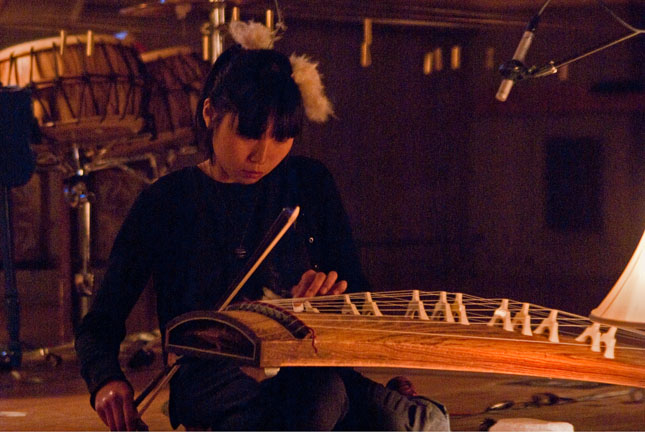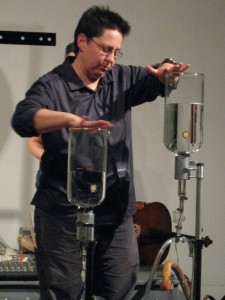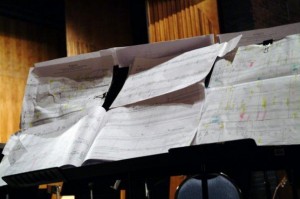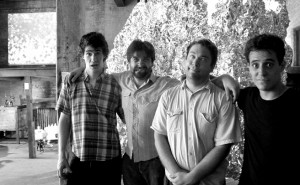Andrew Ford’s “Illegal Harmonies”

“I’ve never had a grand plan. Never even had an ambition – I still don’t, beyond wanting to write better music,” says Ford. “So I’ve done things as they’ve come along. Of course I also say no to things. I got into writing music journalism because, in 1983 when I came to Australia, I wasn’t, over all, very impressed with the music journalism I read. My radio work really came out of being an academic and gradually replaced it totally.”
Although born in England, Andrew Ford has become associated with his adopted homeland, Australia. He’s one of the most astute commentators on the country’s music scene, hosting “The Music Show,” a weekly broadcast on ABC Radio National since 1995.
“I live in the country, and most weeks I compose from Monday to Thursday. Then on Friday I drive the two hours up to Sydney and my producers hand me a folder full of research and a bunch of CDs relating to the guests I will have on The Music Show the following morning. There are usually four and we try to mix things up: I might talk to a jazz singer, a didgeridoo player, an opera director and the composer of a new string quartet. I do the show live, and then drive home on the Saturday afternoon. I try not to work on Sundays. If I’m writing a book, of course, that might have to take over for a while.”
Ford has written several books, and while most are accessible to a general audience, he’s never shy about exposing his readers to a wide array of adventurous music. He’s also the rare interviewer who’s able to “talk shop” with composers from the vantage point of a fellow practitioner. This is clearly demonstrated in Composer to Composer (1993), an excellent collection of interviews he conducted with many of Australia’s finest composers, as well as composers from elsewhere, such as the UK’s Brian Ferneyhough and Americans John Cage and Elliott Carter. Another one of his collections, Illegal Harmonies, has just been reissued in its third edition by Black, Inc.
Ford says, “Illegal Harmonies was a history of music in the 20th century and began as a radio series in 1997. There were ten 90-minute episodes, one for each decade. The book was published the same year, and this is its third edition. I’ve added a new preface and also there’s a new epilogue looking at music in the first decade of the 21st century.”
Black, Inc. has also recently published Ford’s latest book, The Sound of Pictures. He says, “Funnily enough, the book isn’t really about film scores. I’d say that, more accurately, it’s about films and how they used music and sound in general. It looks – and especially listens – to a lot of films, and finds some connections between them. The way films use sound to plant clues – including false clues – or to undermine, as well as reinforce, what is happening on the screen.”
Those wishing for an entrée to Ford’s own music might start with The Waltz Book, a recent CD release on the Tall Poppies imprint. It consists of sixty one-minute long waltzes performed by pianist Ian Munro. But these are hardly your garden-variety Viennese dance pieces by Strauss. They explore a wide array of sound worlds, using waltz time as a jumping off point for some truly imaginative musical excursions.
Ford says, “The piece was never really about waltzes. It was an attempt to build a single large structure out of a lot of small structures. I felt these small pieces should all be the same size – like a mosaic – but that each might have its own personality and be performable as an independent miniature. A minute seemed the obvious length for each piece, and having decided that, the idea of the minute-waltz followed. Of course, the fact that each minute is a waltz – or at least waltz-related – brings a kind of unity to the hour-long whole, but what interested me above all was two things. First, I wanted to experiment with putting different amounts of music into the minute molds: you can have a minute of furious activity, or a minute of Satie-like blankness. Second, I wanted the overall structure of the hour to be coherent. That’s a long time listening to piano miniatures, and the audience needs to have its attention held: there had to be a sense of a journey or a story being told. You can imagine that at the first performance I was quite nervous!”
Another of Ford’s most recent pieces found the composer working in another medium with a storied tradition: the brass band. The Black Dyke Band premiered his work The Rising at the Manchester Brass festival in January 2011.
Ford says, “Without wishing to make a pun, writing for a brass band was a blast, and especially writing for the Black Dyke Band which is the UK’s finest and has more than 150 years of history behind it. They can play anything – they are total virtuosi. I’d never written for band before. I wasn’t even terribly sure what a baritone horn was. I did my homework, but I confess there was an element of guesswork involved. But the piece came out well. It sounded just as I’d hoped. Better, in some ways, because one thing I’d failed to appreciate was just how homogenous the sound is – it’s like they are all playing different sizes of the same instrument. It was this big glowing mass of sound – the Berlin Philharmonic under Karajan – and I am completely hooked. I would love to write another band piece.”
Which other works would Andrew Ford like for listeners from outside Australia to hear? “I’m very happy with my Symphony (2008). I feel that, perhaps out of all my pieces, you could say this was really typical of me. There are no references, no extra-musical stuff: it’s just my music. And fortunately you can hear (and see) Brett Dean conducting the premiere of the piece at my website. I’ve revised it slightly since then, but nothing major. My opera, Rembrandt’s Wife (2009), is another piece I am very happy with. I had a brilliant libretto (by Sue Smith) and I tried to make it into one long song. I was determined it would be full of real singing from start to finish. It was a joy to write and I’ve never felt so unselfconscious in writing a piece. It felt as though it wrote itself. What else? Maybe Learning to Howl (2001), a song cycle for soprano, soprano sax/clarinets, harp and percussion, to words mostly by women.”
“One long-term project is called Progess. My earliest pieces – when I was a teenager – were rather influenced by Stockhausen’s then current intuitive music. This was convenient, in a way, because I must admit that I didn’t really know how to write everything down. As my technique improved, I have always wanted to return to that, to introduce more freedom into my pieces, but the trouble is I keep hearing them rather clearly in my imagination and I end up notating what I hear. Progress, right from the start, is designed as a fluid piece, with hardly anything pinned down and the players asked to improvise in various ways and based on certain melodic models. The instrumentation is totally flexible and so is the spatial layout. Indeed perhaps the most interesting thing about it is the way it will accommodate itself to the building in which it is performed – literally filling the building (not just the main performance space – even assuming there is one of these), so that it becomes a musical representation of the building. There will also be recorded voices – something I’ve used quite a lot recently – talking about the place, its history, its significance, what was there before it was built, etc. It should see the light of day next year with further performances in 2013, but it’s early in the process, so I can’t say too much more.”
When asked who, apart from Andrew Ford, are the composers born or residing in Australia that should gain more currency abroad, Ford replies, “David Lumsdaine, 80 this year and now living in the UK, is a very serious voice, I think. What interests me in particular is the way in which his soundscapes and his composed works intersect. There’s a new CD – White Dawn – that places them alongside each other. I’m very drawn to Mary Finsterer’s music, especially her latest stuff. It’s always interesting to observe composers in transition. Of course if you’re not in transition, then you’re drying up.”
Illegal Harmonies and The Sound of Pictures can be ordered via Black, Inc.’s website.
 Kanoko is classically trained on piano and received a BA in music performance from Mills College in 2006. Her recent interest has primarily been in performing 20th century and contemporary music on piano and koto, and free improvisation in a variety of contexts. SF Bay Area contrabassist
Kanoko is classically trained on piano and received a BA in music performance from Mills College in 2006. Her recent interest has primarily been in performing 20th century and contemporary music on piano and koto, and free improvisation in a variety of contexts. SF Bay Area contrabassist 
 Andrew Raffo Dewar
Andrew Raffo Dewar


